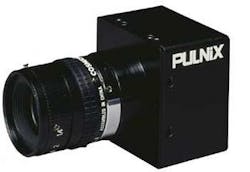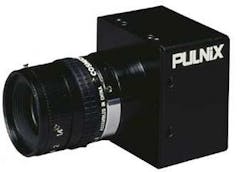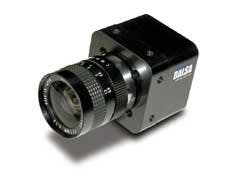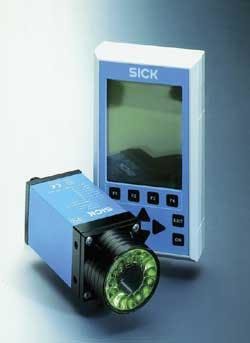CMOS cameras battle for niche applications
By Andrew Wilson, Editor
Compared with CCD cameras, CMOS camera features narrow their use to high-speed and low-light-level machine-vision applications.
Recent market predictions that CMOS sensors would replace CCD imagers in industrial camera designs were optimistic. Although CMOS devices integrate imagers, timing and control circuitry, analog-to-digital conversion, and other logic circuitry, they have yet to find acceptance in widespread machine-vision applications. Despite their lower cost, when compared with CCD-based cameras designs, CMOS cameras generally feature lower signal-to-noise ratio, fill factor, and quantum efficiency. These shortcomings have limited their use to high-speed video-capture, low-light-level, and niche machine-vision applications.
"Several key factors determine whether a CMOS camera is suitable for machine vision," says Don Lake, vice president of marketing at Pulnix America (Sunnyvale, CA). "These include whether the camera uses a progressive-scan imager and has an asynchronous readout and a full-frame shutter," he says. Unlike frame-integration-based devices, progressive-scan cameras transfer an entire frame from the image sensor without line interlacing. This method is especially useful in machine-vision applications where images captured from objects moving at high speed are not corrupted.
Because each photoelement in a CMOS sensor array has its own amplifier and output circuitry, photosites can be read out independently. The asynchronous nature of this readout allows areas or regions of interest (ROIs) of the imager to be read out at fast frame rates without a fixed integration time. Unlike CCD devices that rely on a charge-coupled synchronous transfer, the asynchronous readout of CMOS devices can be put to use in high-speed camera designs where ROI speeds of 100,000 frames/s and higher can often be achieved.
ROI imaging
"One major advantage of the CMOS sensor is pixel addressability," says Lake. "Since it has an x-y address readout device similar to a memory device, addressable readout control can generate ROI output, high frame scanning, traveling window of interest (WOI), and tracking in a chip." The programmable WOI can be used for a fast, coarse scan and then, when the WOI is identified, captured full-resolution images can be delivered. The frame rate increases proportionally to the ROI. A ROI containing one-half of the total pixels will roughly double the frame rate. In the design of its PC-640CL camera, Pulnix has incorporated a 640 X 480-pixel, 30-frame/s imager that can be windowed in this manner to produce frame rates as high as 3000 frames/s using a 50 X 50-pixel ROI (see Fig. 1).
Two shutter types are currently used in CMOS imagers. In rolling-shutter-based devices, rows of pixels in the sensor are reset in sequence from top to bottom. After this reset, rows of pixels are read out in sequence, again from top to bottom. The integration time of the device is then equal to the delay between a row being reset and a row being read. Varying the time between the reset and readout controls the integration time of the sensor. Unfortunately, by reading out the image in this way, motion artifacts can occur since photons from the top of the sensor are integrated earlier than light from the bottom.
"When there is substantial motion in the field of view from the time the top of the image is integrating to the time the bottom of the image is read out, there will be motion artifacts," says Steve Nordhauser, vice president of product development at Silicon Imaging (SI; Troy, NY). "Of course, if the sensor is fast (such as the 100-MHz readout rate for the SI-3170), the effect is minimized." For high-frame-rate readout of a ROI, the top-to-bottom frame time is also minimal. Some CMOS cameras, such as the SI-1024, are based on global shutter sensors and do not exhibit this effect. "Since the storage sites at each pixel to achieve the global shutter add to the cost and lower the fill factor, the applications for the two technologies are different," adds Nordhauser.
In the design of its SI-3170 MegaCamera, Silicon Imaging has developed a CMOS camera capable of running at video rates of 30 frames/s at its full 2056 X 1560-pixel resolution (see Fig. 2). Incorporating a rolling shutter, the SI-3170 MegaCamera uses 12-bit digitizers to sample two output taps, each at 50 MHz, to achieve 30-frame/s data throughput and also uses the 10 most significant bits for further processing. For high-definition TV applications, the aspect ratio can be switched from the traditional 4:3 to 16:9 by using ROI readout. As with the Pulnix PC-640-CL, this ROI enables readout rates in excess of 1000 frames/s, allowing the camera to be used for motion analysis or object tracking.
To overcome the limitation associated with rolling shutters, CMOS image-sensor developers can implement a global shutter that resets the entire imager before integration. In operation, these designs are similar to interline-transfer devices. Pixels accumulate charge during integration and are then transferred to a light-shielded storage area and read out. Since every pixel is reset at the same time, integrated over the same time interval, and transferred to the light-shielded storage area at the same time, no motion artifacts can occur.
The KAC-0311 sensor from Eastman Kodak Co. (Rochester, NY) is an example of a CMOS device that uses a global shutter. With a 640 X 480-pixel array in a 1/3-in. optical format, the global shutter simultaneously exposes the entire pixel array rather than sequencing the exposure line by line. Using this device, designers can develop a fully programmable ROI-based camera and use subsampling to provide the higher frame rates needed for autoexposure and autofocus functions.
DTA (Pisa, Italy) has used these CMOS image sensors in a range of cameras. Dubbed the Alpha series, these cameras feature C-mount lenses and can be mounted on both telescopes and microscopes. With a readout speed of up to 20 Mpixels/s, a 10-bit dynamic range, and a partial readout capability, the Alpha series is supplied with a parallel port or a USB interface
Dynamic range
Although the dynamic range of linear CMOS sensors is often less than their CCD counterparts, a number of companies are producing CMOS devices with a high dynamic range that use logarithmic or logarithmic-like responses (see Vision Systems Design, August 2002, p. 31). In these devices, voltage response is presented as the logarithm of the light intensity. This approach allows orders of magnitude of illumination levels to be compressed at the output range and produces dynamic ranges often in access of 120 dB. For relative contrast measurements, the ideal response is the logarithmic response. However, if absolute intensities need to be measured for applications, such as photometry or image calibration, linear-based sensors are a better method.
Targeting industrial imaging and optical metrology, the MV-D1024 CMOS camera from Photonfocus (Lachen, Switzerland) typifies this type of camera. With a dynamic range of up to 120 dB at a resolution of 1024 X 1024 pixels and an acquisition speed of up to 145 frames/s, this camera uses a four-channel, analog, CMOS image sensor, also designed by Photonfocus.
In addition to incorporating a global shutter, the camera can be tuned between a linear and a LinLog response that combines both linear and logarithmic responses for high-contrast applications. Available with digital outputs in LVDS (RS644), Camera Link, IEEE 1394 (FireWire), or analog EIA format, the camera can be optionally supplied with CCIR or RS-170 outputs.
Interestingly, the LinLog sensor also emerges in the latest 1M28-SA stop-action camera from Dalsa (Waterloo, Ontario, Canada). Featuring an electronic, global nonrolling shutter for stop-action imaging, the camera offers a linear response up to a user-defined light level. Beyond that level, the sensor drains away excess charge to provide logarithmic response. The result is an up to 120-dB dynamic response that is useful for imaging dark scenes with bright elements, such as in nighttime license-plate reading.
With a Camera Link interface, the camera uses the Photonfocus 1024 X 1024-pixel, CMOS image sensor to output 27 frames/s at full resolution (see Fig. 3). Frame rates over 100,000 frames/s can be achieved through ROI windowing. "While the camera is well suited for robotics control, traffic management, and welding inspection applications, says Dalsa product manager Mark Butler, "applications requiring scientific-image quality, such as high-precision metrology, medical imaging, or microscopy, require a premium image quality camera such as the 1M30."
Photoelectric replacements
Despite the benefits touted by CMOS vendors, the image quality obtained by CMOS cameras is generally not as good as that obtained by CCD-based cameras. After showing the company's PC-640CL CMOS camera to a number of systems integrators, Pulnix's Lake found that "every one of them was disappointed that the CMOS images were not as good as those from Pulnix CCD-based cameras. Although the images from the PC-640CL camera are as good as any from a CMOS camera, customers did not want to substitute them for CCD camera images. However, when we showed images to customers who had been using photoelectric sensors in their systems, the view was totally different. Those customers saw an great increase in functionality for a small cost increase," he says.
Recognizing this trend, a number of industrial-automation-sensor manufacturers have started to offer low-cost CMOS-based image sensors that bridge the divide between photoelectric sensors and CCD cameras. Last month, for example, Sick Inc. (Minneapolis, MN) introduced its ICS 100 integrated, intelligent camera sensor designed for presence monitoring and object detection (see Fig. 4). While its technical specifications are far from those of a high-end CCD camera—it features a 512 X 512 X 4-bit CMOS imager—it can be used for simple imaging procedures such as checking whether an object is present by summing binary pixels in the image.
The ICS 100 sensor has found applications in checking for the presence of revenue stamps on boxes of cigarettes. During operation, two cigarette boxes at a time are moved past the ICS 100 by a transport system. The CMOS imager captures the image, converts it to binary form, and sums the pixels generated by the stamps. If enough pixels are detected, the revenue stamps are present, and the box is transported onward. Units with missing revenue stamps are diverted away.
Due to their low cost and integrated functions, CMOS-based cameras are bound to find new applications in nondemanding machine-vision applications such as object-presence detection. In high-speed image capture, too, their less-than-CCD-image quality will be compensated for by ultrahigh-frame-rate ROI windowing and ease of use. In high-dynamic-range applications, such as embedded automotive inspection, CMOS cameras price/performance characteristics are anticipated to replace CCD designs. However, for the present, mainstream machine-vision applications such as web inspection will continue to demand the performance of CCD cameras.




